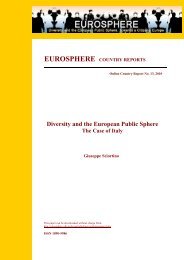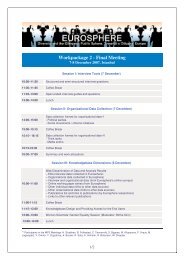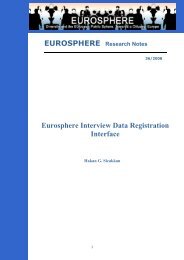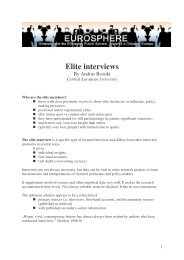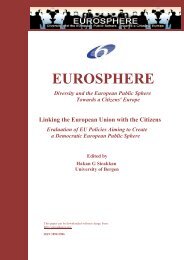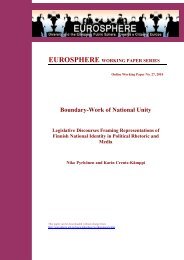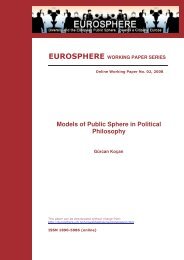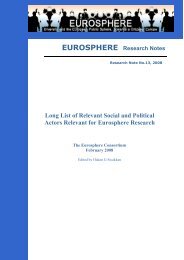Migrants, Minorities, Belongings and Citizenship. Glocalization and ...
Migrants, Minorities, Belongings and Citizenship. Glocalization and ...
Migrants, Minorities, Belongings and Citizenship. Glocalization and ...
You also want an ePaper? Increase the reach of your titles
YUMPU automatically turns print PDFs into web optimized ePapers that Google loves.
diverse society. In other words, the glocal space was a laboratory where one could<br />
observe the alignments <strong>and</strong> misalignments in somewhat controlled social environment.<br />
The fieldwork sites were selected by each partner with respect to an operational<br />
definition of a glocal space. The respondents were selected with respect to their<br />
“objective belonging” to the six categories that Glocalmig studies. Between 3 to 5<br />
persons would be selected from each category <strong>and</strong>, if persons belonging to a category<br />
were not found in the respective fieldwork site, the reason for this would be accounted<br />
for in each country report. In addition, both genders would be properly represented in<br />
the samples. Basically, persons who were present in the fieldwork site at the time of the<br />
fieldwork were interviewed. As a result, we managed to find respondents with varying<br />
degrees of participation in the glocal spaces as well as people who also attend to other<br />
spaces such as ethnic organizations, corporate-plural organizations, nation-wide spaces<br />
of participation, transnational spaces, etc. Such a r<strong>and</strong>om selection of the respondents,<br />
thus, allowed us to observe the mobility between different channels of participation <strong>and</strong><br />
of rights-exercise.<br />
Due to certain context-specific reasons, some of these site-selection criteria were not<br />
satisfied by the potential fieldwork site in Estonia, <strong>and</strong> the fieldwork in Tallinn was<br />
therefore conducted in multicultural sites instead of glocal sites. On the other h<strong>and</strong>,<br />
because glocal sites proved to be much more informal <strong>and</strong> de-territorialized in Budapest<br />
than in the other five cities, the snowball method of respondent selection had to be used<br />
in the fieldwork in Budapest.<br />
The respondents were first asked to fill in the questionnaire <strong>and</strong> then invited to an indepth<br />
interview. The questionnaire was a comprehensive one; <strong>and</strong> it required the<br />
respondents to ponder over certain questions that they had not thought of before. In this<br />
sense, the questionnaire was also time-wise dem<strong>and</strong>ing; but most of the respondents<br />
managed to complete the questionnaire. On the other h<strong>and</strong>, some of the questions were<br />
deliberately provocative (different provocative questions for different categories of people<br />
were used). Most of such questions were designed in order to prepare – not to influence<br />
– the respondents for the qualitative in-depth interviews. Most respondents took up the<br />
provocative questions themselves during the interviews, which proved to result in better<br />
<strong>and</strong> more accurate findings.<br />
The following in-depth interviews comprised structured, semi-structured, <strong>and</strong> openended<br />
questions about respondents’ belonging <strong>and</strong> identity patterns, participation<br />
patterns, psychic mobility, etc. The complementary application of a questionnaire <strong>and</strong> indepth<br />
interviews resulted in a more nuanced data material. The method used for<br />
31



